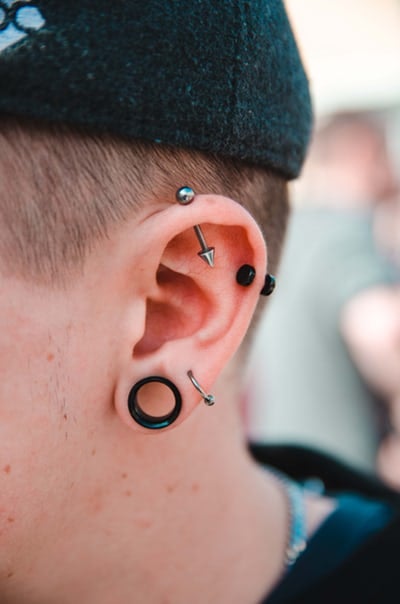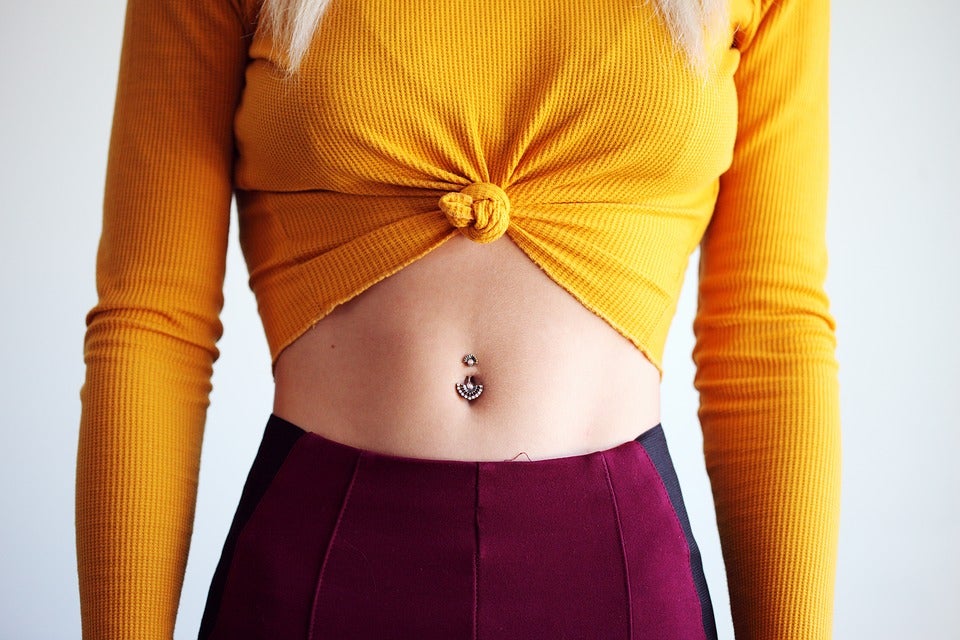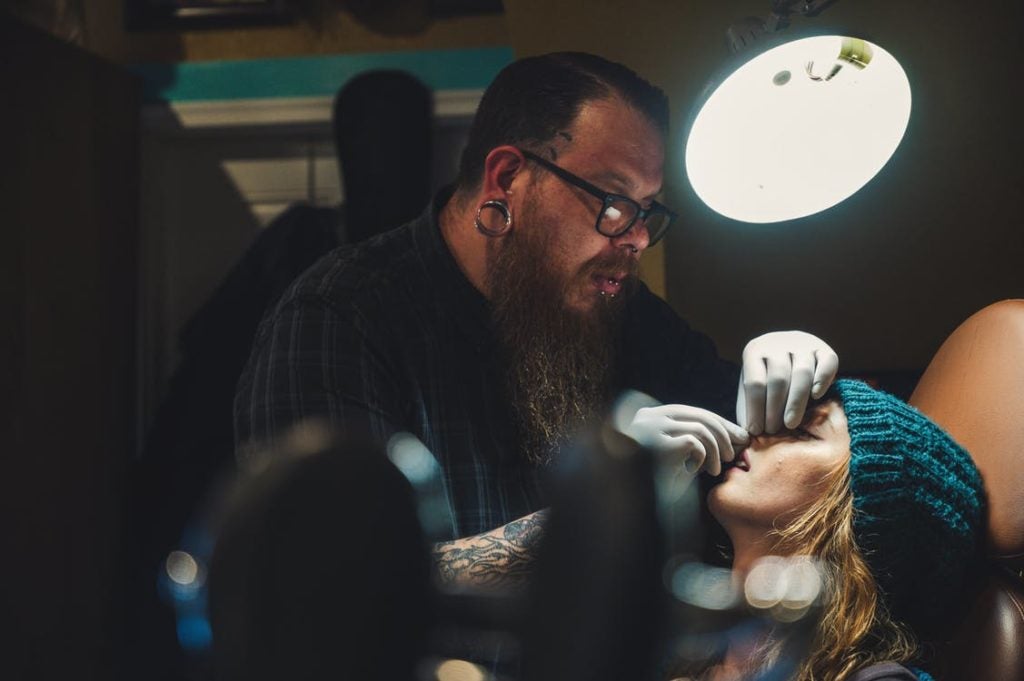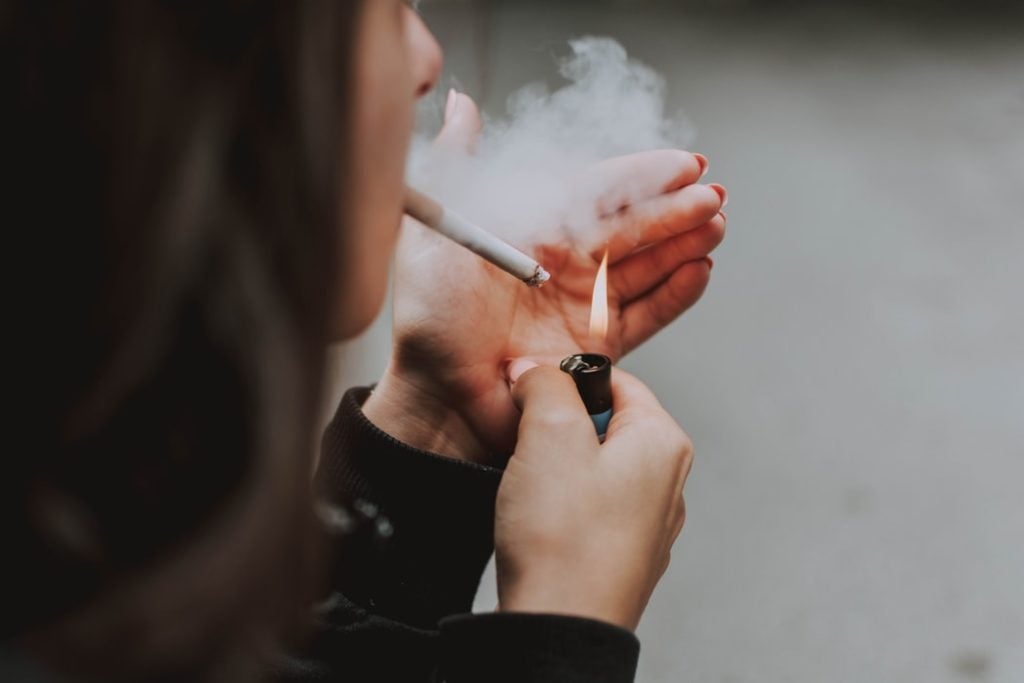Body piercing is popular all over the world and has a long history among many different cultures. For example, piercings have been discovered on mummified bodies and there are references to earrings in texts from several different ancient civilizations.1 Piercings are still a popular form of body modification today, and there are many different types available. People view them as a creative form of self-expression or simply as an aesthetically pleasing form of decoration. Genital piercings can also increase sensitivity in erogenous zones. This article covers the different types of body piercings, the risks involved, and information on how body piercings can affect one’s sex life.

Types of Body Piercings
There are many body piercings available, and people choose to get them for different reasons. This list explains the most popular types of body piercings along with their pain levels and healing processes.

- Ear piercings: The ears are the most common body part that people choose to pierce. Piercings on the earlobes involve minimal pain and typically heal in about six to eight weeks. It is recommended to rotate the earrings every day while they are healing and clean the area twice a day with the proper cleaning solution.4 Cartilage piercings are more painful than lobe piercings and can take about three to six months to heal. Most piercers recommend cleaning a cartilage piercing several times a day with both saline solution and antibacterial soap. It is also not advised to touch the piercing or rotate it during the healing process.5
- Nose piercings: The nose is another popular area to pierce; both nostril and septum piercings are common today. Nostril piercings heal in about two to four months, while septum piercings can take six to eight months. Septum piercings tend to be more painful than nostril piercings because the septum is an area with thick cartilage. Nose piercings should be cleaned with antibacterial soap twice a day and rinsed with saline solution once a day.6

- Surface piercings: A surface piercing is any piercing that is threaded through the surface of the skin, such as the nipples, navel, neck, arms, wrists, fingers, and eyebrows. Nipple piercings are the most painful type of surface piercing. Surface piercings take about three to six months to heal, and should be cleaned two to three times a day with saline solution until fully healed. It is best to avoid swimming or taking baths before the piercing has healed, as this can lead to infection. Nipple and navel piercings can be particularly difficult to heal because those areas of the body are often covered by clothing. Wearing loose clothing during the healing process will help minimize irritation of the piercing.7

- Genital piercings: There are several types of genital piercings available. For males, potential locations for genital piercings include the scrotum, perineum, and the glans and shaft of the penis. Females can be pierced on the clitoral hood, labia, mons pubis, or perineum.8 Genital piercings are among the most painful of all body piercings. Many genital piercings heal within four to six weeks, but some can take months to heal. Individuals should consult their piercer regarding the appropriate amount of time to wait before engaging in sexual activity. During sex, individuals with a healing piercing should avoid bodily contact with the piercing and make sure to clean it immediately following an encounter. Additionally, sex toys should be used with a clean, disposable barrier to avoid bacterial contamination. Each type of genital piercing has specific cleaning instructions, so it is best to consult with your piercer about the proper aftercare routine for your individual piercing.9
Female Genital Piercing
Females may choose to pierce their genital area for many reasons, including aesthetic and enhancement of sexual pleasure. Just like male genital piercings, there are many potential complications involved. However, with a reputable piercer and proper aftercare, genital piercings can be a pleasing decorative element with the added benefit of increased arousal.
Clitoral hood piercings are one of the most popular genital piercings for females. Rather than piercing the glans of the clitoris, it is more common and safe to pierce the clitoral hood either vertically or horizontally. Vertical piercings take about four to eight weeks to heal and generally provide more sexual stimulation because the jewelry rests vertically on top of the clitoris. Horizontal piercings heal in about six to eight weeks and provide less stimulation. They are recommended if a female is getting the piercing for aesthetic reasons.17

The inner and outer labia are also common locations for female genital piercings. The inner labia are more painful to pierce due to the high concentration of blood vessels and nerves in that area. Labia piercings are typically done for aesthetic reasons and provide less stimulation than clitoral piercings. Inner labia piercings take about four to six weeks to heal, while the healing time for outer labia piercings is about two to three months.17
Christina piercings are another popular option. These are surface piercings that are located on the mons pubis directly above the clitoris. They do not provide sexual stimulation and are strictly valued for their aesthetic appeal. They tend to heal in about three to four months. Surface piercings are already more prone to infection than other types of piercings, and the Christina piercing is especially risky due to friction from pants and underwear. It is recommended to wear loose clothing whenever possible to avoid irritating the piercing.17
Male Genital Piercing
Many men looking to increase the stimulation they receive from sex decide to get a genital piercing. Piercings on male genitals can have serious complications but, if performed well and properly cared for, can greatly increase the pleasure of sex. There are many piercings available and each should be carefully considered and researched before being performed by an experienced professional.
The most popular male genital piercing is the Prince Albert. It has the fastest healing time and is considered the most sexually appealing male piercing. This piercing goes into the urethra and comes out the bottom of the head. A variation of this piercing, called the reverse Prince Albert, comes over the top of the head. This piercing requires less cleaning than most because urine is sterile and aids in the healing process; however, most men will have to sit down in order to urinate because the piercing causes urine to be expelled in a spraying manner. Allow two to four months to heal and one week of abstinence. Condom use is advised until fully healed.15

The ampallang piercing is a piercing through the head of the penis that can be placed above, under, or through the urethra (transurethral). Straight bars are required for this piercing that goes horizontally through the head of the penis. This can be a very uncomfortable and painful piercing due to the thickness and sensitivity of the glans; this piercing could take several seconds to perform as it must be done slowly. The piercing may bleed for up to five days and will take anywhere between 4 to 12 months to heal. Two weeks of abstinence are required after getting the piercing and extreme care must be taken until the glans is completely healed. This piercing is often sought after for sexual reasons: the bearer of the ampallang receives stimulation of the internal tissues. Female partners may also find the piercing pleasurable during intercourse due to the stimulation of their G-Spot.16
Similar to the ampallang, the apadravya goes through the glans of the penis; however, this piercing is placed vertically through the head. Complications include migration or gradual rejection of the jewelry. This piercing is slow and painful, so it is important that it is performed by an experienced piercer. The piercing itself, which is considered the most pleasurable for female partners, can be placed through or around the urethra but must not puncture the corpus cavernosum.16
The dydoe is an anatomy-dependant piercing, which means that it is typically requested by circumcised men. It is still possible to perform a dydoe piercing on uncircumcised men; however, the presence of the foreskin keeps the area moist and hinders the healing process. Most commonly the ridge of the penis’s head is pierced by a curved barbell. It is said to increase stimulation of the glans where its sensitivity may have been damaged from circumcision. The dydoe is considered one of the most painful piercings. Condom use is strongly recommended until the piercing is fully healed.16

How Piercings Affect Your Sex Life
Many popular piercings are located in erogenous zones (even the ears have a slight erotic connection). Piercings may enhance sex by providing a greater degree of stimulation. Areas such as the tongue and nipples are very popular places to be pierced because of the extra stimulation they provide. Clitoral hood piercings and other piercings in the clitoral area can provide extra stimulation for females during sexual activity. In addition, penis piercings can provide G-Spot stimulation to a female partner during intercourse.8 Some report genital piercings to be very effective for enhancing sexual pleasure.
There are several cautionary steps that individuals with genital piercings should take to avoid pain or infection during sexual activity. First, try to wait until the piercing is fully healed to engage in sexual activity. If abstaining for the full duration of healing time is unrealistic, wait at least two weeks.9 Barrier methods such as a condom or dental dam should be used during sex to prevent bodily fluid or bacteria from entering the piercing. Try to avoid touching the piercing or bumping into it, and stop what you are doing immediately if you feel pain or discomfort during sexual activity.8
Finding a Good Piercer
Your body is something that must be treated with the utmost care. Because the process of body piercing involves inserting a needle into your skin, there is always a risk of infection or complications. However, these risks will be significantly reduced if you take proper steps to ensure that the piercing process is safe and hygienic. One of the most important steps is finding a licensed piercer who is experienced and knows proper sterilization and piercing techniques.

So how do you decide if a piercer is competent? Ask around; see what kind of reputation different establishments have. Check with you local Health Department (in most places piercers are required to be registered) and ask for a recommendation. Once you have decided on a piercer, call or see them, and don’t be afraid to ask questions. Have a look around the shop — it should look and smell clean and the piercing should be done in a separate room (for privacy and hygiene). Ask them how they sterilize their instruments and jewelry (autoclaving is the only safe method). All needles should be in autoclave or commercial packaging, and should be opened just prior to the piercing, and then disposed of immediately.2
To minimize the risk of infection, the piercing should be performed using aseptic or “sterile” techniques, which require that all supplies used during the piercing come out of sterile packages; this includes gloves, tools, and jewelry. The jewelry should either be sterilized in autoclave bags or disinfected in a hospital grade disinfectant like Madacide or Wavicide. This method is only suitable for clean, new, unused jewelry. Piercers should provide you with a detailed aftercare sheet that outlines the procedures you need to follow to look after the piercing while it’s healing and the aftercare products you need to use.2
Healing Process
For most piercings there will be some initial sensitivity for the first two to three days, but the healing process may be different for any piercing of mucous membrane areas like the tongue, lips, or genitals. This is because these areas are highly vascularised (have a high concentration of blood vessels), causing them to swell when pierced. Soreness may last from a few days to a few months depending on how well one takes care of the piercing (i.e., cleaning it sufficiently and refraining from bumping it).3

There are many factors that may affect a body’s ability to heal a wound, such as a person’s general health. Being sick, exhausted, or overworked can weaken the immune system, delay the healing process, and increase the risk of infection. Smoking, poor diet, obesity, and lack of exercise can contribute to delayed healing.3
Any contact with a piercing has the potential to cause irritation and can result in inflammation. Playing contact sports or working in a job that requires manual labor may make a nipple or navel piercing impractical. Swimming in a public pool increases the risk of developing an infection; however, the piercing can be covered with a waterproof bandage. Wearing tight clothes, touching the piercing with dirty hands, coming into contact with bodily fluids, using rough treatment, and applying inappropriate cleaning agents can all hamper the healing process. Following the instructions in the care sheet carefully will minimize problems and dramatically reduce healing time.3
Infected Piercings
Ideally, with proper cleaning and aftercare, a piercing will heal in a reasonable amount of time without complications. However, since piercings are essentially open wounds on the body, they are prone to infection. It is important to know the difference between a piercing that is healing properly and one that is infected. It is normal for a healing piercing to be sore and for the pierced area to have minor redness or swelling.5 It is also common to see a clear or white crust around the piercing while it is healing; however, if the piercing has a yellow or green pus-like discharge or if it continues to be extremely painful and swollen during the healing process, this could mean that it has become infected.
If you think your piercing may be infected, make sure to clean it and to see your piercer as soon as possible. Do not remove the piercing, as this could cause the infection to become trapped inside the skin as it heals around the infected piercing.10 Your piercer will be able to examine the piercing to determine if it is infected and give you instructions on how to care for it.
Potential Risks of Body Piercings
There is a chance of acquiring a serious infection if the piercing is done by someone who is inadequately trained.11 Responsible piercers follow the principles of aseptic or “sterile” techniques, which are the cleaning methods used for surgical operations and provide the lowest risk of infection. Autoclaving, the process that is used in hospitals, should be used to sterilize all instruments and jewelry. Sterile dressing packs, gloves, and single-use needles should be used for each customer, and they should be opened in front of you before the piercing and immediately disposed of in front of you, into an appropriate container.2
If you use a reputable, qualified, and responsible piercer, your chances of getting an infection are minimal; however, it is your responsibility to ensure that the piercing is performed safely. So do the research and check out each potential piercer thoroughly. If they are professional, they should be happy and able to answer any of your questions.
There are several medical problems that make it dangerous for certain individuals to get a piercing. Diabetes and haematopoietic abnormalities both present difficulties for piercing, because they reduce the body’s ability to heal wounds properly. The increased incidence of infections associated with diabetes may also contribute to impaired wound healing.12 Hemophilia is another risky condition because hemophiliacs have a greater tendency to hemorrhage and a greatly reduced ability to heal wounds; this disease precludes piercing.13 If you have one of these conditions, it may be too risky for you to get a piercing. If in doubt, consult your doctor.
Nipple piercings can sometimes cause difficulties for breastfeeding, such as reduced milk supply and problems with the infant latching to the breast and suckling. Additionally, nipple rings present a choking hazard if the ring dislodges into the infant’s mouth. Many women with nipple piercings are able to breastfeed successfully without these complications, but it is best to be aware of the risks. If problems do occur with breastfeeding, it is recommended to remove the nipple rings.14

Concluding Remarks
Body piercings can be an enjoyable form of decoration, self-expression, or sexual enhancement. There is a wide array of options for individuals who wish to get a piercing. Many body piercings are simply decorative, while some genital piercings have the additional benefit of sexual stimulation and increased pleasure. As long as one does the research to find a reputable piercer and follows the proper aftercare regimen, piercings can be a positive and rewarding experience.
References
- “History of Body Piercing.” Basic Body Piercing Advice.
- “Genital Piercings.” Web MD.
- “Taking Care of Your New Piercing.” Association of Professional Piercers.
- Ketcham, Sandra. “How to Heal Newly Pierced Ears.” Livestrong, 18 July 2017.
- Davies, Lilly. “Cartilage Piercing Care, Healing and Cleaning Guide.” Authority Tattoo.
- Holley, Casey. “The Healing Process of a Nose Ring.” Livestrong, 18 July 2017.
- “Surface Piercing FAQs.” Painful Pleasures, 25 July 2015.
- “The Basics of Male and Female Genital Piercings.” Painful Pleasures, 28 February 2014.
- “Genital Piercing Aftercare.” Painful Pleasures, 22 March 2015.
- Schaefer, Anna. “How to Treat an Infected Ear Piercing.” Healthline, 5 July 2017.
- “Getting HIV from Needle Use: Less Common Ways.” Center for Disease Control.
- “Body Piercing and Diabetes.” Diabetes.co.uk.
- Aldridge, Sarah. “Body Piercings and Bleeding Disorders.” Hemaware.
- “Breastfeeding and Nipple Piercing.” Australian Breastfeeding Association.
- “What Is a Prince Albert Piercing and How Does It Work?” Painful Pleasures, 08 Novermber 2014.
- “Piercings Exclusively for Men.” Painful Pleasures, 04 January 2015.
- “Female Piercing Options.” Painful Pleasures, 21 December 2014.
Last Updated: 15 May 2018.
